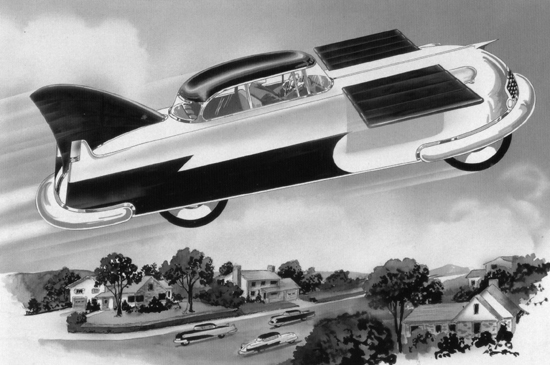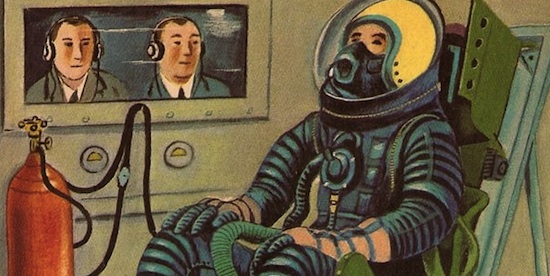The World Will Be Wonderful In The Year 2000!
The secret formula for predicting a fantastical yet credible future
/https://tf-cmsv2-smithsonianmag-media.s3.amazonaws.com/filer/201202291001031959-solar-house-470x251.jpg)
The February 8, 1952 Delta Democrat-Times (Greenville, MS) ran a piece from Henry C. Nicholas titled “Cheer Up! World Will Be Wonderful Fifty Years From Now!” Nicholas reports on the International Congress of Astronautics in London and the convention of the American Chemical Society in New York, saying that the predictions described in the article are not those of imaginative writers of science fiction, but rather the “sober conclusions of our greatest scientists, including many of our most famous Nobel laureates.”
This style of laying out fantastical advances of the future and proclaiming that they represent the conservative opinion of incredibly smart people is one of the most popular formulas of non-fiction futurism writing, dating back at least to John Elfreth Watkins, Jr. and his article for the December, 1900 issue of Ladies’ Home Journal, “What May Happen in the Next Hundred Years.” And this 1952 article is a terrific example of the techno-utopian thinking that so many people today consider the Golden Age of Futurism.
There will not be another world war during this century. The next 50 years will witness an amazing increase in wealth and prosperity, with a continuous rise in the world standard of living. The threat of world overpopulation will disappear with ample space for everyone, thus removing one of the long existing causes for wars and revolutions.
By the year 2000 cures for most of the diseases of man will have been discovered. The average age will be about 100 years. Journeys through space in rocket ships will be an established form of transportation, with regularly scheduled trips to the various planets. A number of man-made moons will be circling around the earth.

The atomic-powered flying car of the future by Frank R. Paul (1955)
The article quotes Dr. James Bryant Conant, the president of Harvard University, about the future of atomic war. Interestingly, the article claims that atomic energy will have proved a failure, making way for solar energy as an “inexhaustible source of new power.” This hope for the future of solar power actually wasn’t a new idea, as similar predictions were made during WWII about the prevalence of solar power after the war (should the world continue to exist at all).
An atomic world war was averted in the 1950s, though by the “narrowest of margins,” according to Dr. James Bryant Conant, world famous chemist and president of Harvard.
The Communist world and its opponents, which then controlled most of the world, became somewhat mellowed by “time and local conditions” and the startling new revelations of the mysteries of the universe.
Atomic energy had been a disappointment, both as a destructive weapon of war and its constructive peacetime development. In the 1970s atomic energy was replaced by solar energy as an inexhaustible source of new power.
With this development, which was fully established by 1985, the world at last realized its age-old dream of lifting most of its labor from the backs of man.
Dr. Adolph Butenandt of Germany and other Nobel laureates from Sweden, Finland, England, France and America, were in agreement with Dr. Conant that solar energy would revolutionize the world through supplying man with an inexhaustible and previously largely untapped source of cheap power.
The amount of such cheap power available to the world in the year 2000 will be beyond comprehension. The amount of sunshine energy, which yearly falls on only a few acres of land, when converted into man-made power was sufficient to supply enough electricity for a city of a million inhabitants.
The article also quotes Artturi Virtanen, a 1945 Nobel Prize recipient in chemistry. According to the piece, in the year 2000 the sea will be explored and exploited for its untapped resources, and the world’s food supply will increase 50 times over.
Fifty years from now the world will be able to increase its food supply 50 times over. This increased production will come largely from enhancing the efficiency with which plants use sunlight to make sugar from water and carbon dioxide.
Fishing will not be the only crop obtained from the sea. There is more wealth in any square mile of the sea than there is in any square mile of land.
With the abundant and almost costless power of solar energy it will be possible to mine the minerals and harvest the green growth that teems in the ocean. Fresh water will be obtained from the ocean and great deserts that are near the sea, like the Sahara in Africa, will become garden spots.
Birth control is seen as the answer to the world’s population crisis, as the article predicts that religious leaders will become more comfortable with the idea of birth control.
There will be no danger of world overpopulation. The size of families and nations will be regulated at will. The world population will controlled through improved birth control methods, with cheap, harmless and temporarily effective anti-fertility compounds added as one saw fit to the diet. This will remove one of the greatest dangers to world peace since the dawn of civilization.
The attitude of religious leaders regarding birth control, say these scientists, will slowly change “without any diminution of religious feeling.”

An illustration from the 1958 Little Golden Book, Exploring Space
Space travel is also seen as just over the horizon, as the article quotes from Wernher von Braun. It’s interesting to remember that the Soviet Union’s launch of Sputnik was still five years away.
There was general agreement among the scientist gazing into their crystal balls that space travel will be an established means of transportation well before the year 2000.
Dr. Wernher von Braun, who was the chief developer of the V-2 rocket for Hitler and who is now working on guided missiles for the United States, said that most of the problems of space navigation will have been solved during the 1950s.
The first step toward true space navigation were earth moons — man-made satellites high in the earth’s atmosphere. Persons stationed on these earth moons continuously circulating around the world, will be able to observe and report any unusual activity that threatens peace on earth.
Supported against the earth’s gravitational pull by the centrifugal force of its rapid motion, only moderate power will be needed to launch space ships from these satellites which possess no atmosphere.
While the world will be changed beyond recognition in the year 2000, say these scientists, man will remain much the strange and unpredictable creature he is today. There will still be many bemoaning the passing of the “good old days.”
(The 1955 illustration above by Frank R. Paul was found in the wonderful book Driving Through Futures Past by the Petersen Automotive Museum in Los Angeles, CA.)
/https://tf-cmsv2-smithsonianmag-media.s3.amazonaws.com/accounts/headshot/matt-novak-240.jpg)
/https://tf-cmsv2-smithsonianmag-media.s3.amazonaws.com/accounts/headshot/matt-novak-240.jpg)